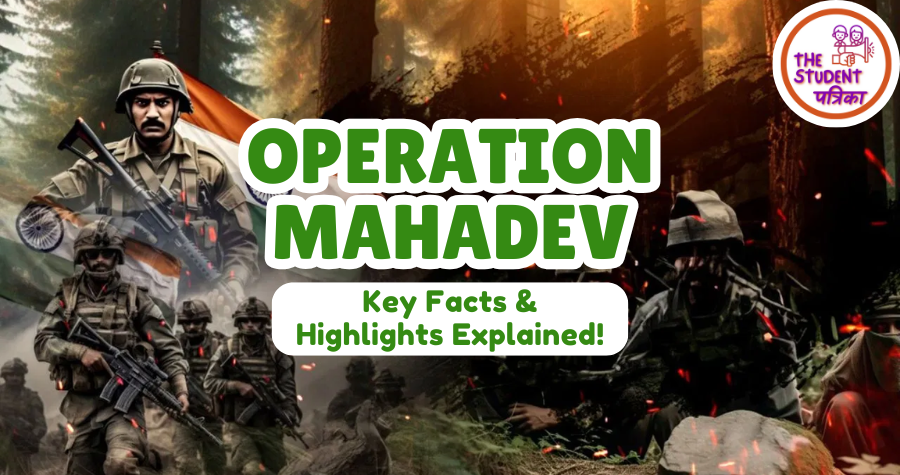
On 28 July 2025, India’s security forces carried out Operation Mahadev, a focused counter-terrorism action in Srinagar’s Harwan forests, swiftly neutralizing three terrorists—including the suspected mastermind of the April 2025 Pahalgam attack that claimed 26 civilian lives. The incident marked a significant escalation in India’s security response and showcased operational precision and resolve.
Background: Why Operation Mahadev?
Following the brutal assault on 22 April 2025—where Lashkar‑e‑Taiba-linked terrorists targeted non-Muslim tourists in Pahalgam, killing 26 individuals—India launched Operation Sindoor in May 2025. The aim was to dismantle terror infrastructure across Pakistan and Pakistan‑occupied J&K. Though Operation Sindoor inflicted damage on militant structures, national leadership emphasised accountability for perpetrators, setting the stage for Operation Mahadev.
The Operation in Detail:
Acting on real-time intelligence inputs, elite units including the Para Commandos and Rashtriya Rifles, supported by Jammu & Kashmir Police and CRPF, conducted an operation in the Harwan–Dachigam region near Srinagar. Within just three hours, the forces tracked and eliminated the terrorists using a Chinese satellite phone monitoring device, reportedly used by one of them—Hashim Moosa (alias Suleman Shah)—who is believed to be the planner behind the Pahalgam strike.
The intense engagement occurred in the Mahadev Peak area, where the three suspected terrorists were neutralized in coordinated action. While official confirmations of identities are pending, government sources suggest one was indeed the Pahalgam mastermind.
Impact & Message:
-
Union Home Minister Amit Shah, briefing the Lok Sabha, confirmed all three terrorists were Pakistani nationals involved in the terror strike—and celebrated the precision and speed of the response.
-
J&K Chief Minister Omar Abdullah called it “good news,” saying this operation strengthens the morale of security forces and undermines communal reconciliation narratives pushed by terror acts.
-
Families of attack victims expressed relief—one victim’s relative said, “Pain remains, but peace begins today,” reflecting emotional closure for communities still healing.
ALSO READ: Operation Sindoor Explained
Exam Focus Points:
-
Name & Location: Operation Mahadev—targeted at Harwan forests near Dachigam and Mahadev Peak in Srinagar.
-
Date of Execution: 28 July 2025
-
Agencies Involved: Para Special Forces, Rashtriya Rifles, Jammu & Kashmir Police, and CRPF participated in the coordinated strike.
-
Tactical Innovation: Triggered by monitoring a satellite phone call associated with the attack planning.
-
Immediate Outcome: Three terrorists killed; one confirmed as Hashim Musa, alias Suleman Shah—identified as the operational planner of the Pahalgam massacre.
-
Broader Context: Follow-up to Operation Sindoor; part of India’s overall counter-terror strategy.
Why Operation Mahadev Matters?
-
It signifies India’s intelligence-driven precision response within its territory post-Pahalgam incident.
-
Reflects operational synergy among forces under active counter-terrorism protocols.
-
Serves as a deterrent to terror networks, reinforcing India’s domestic narrative on national security and retaliation.
-
It sends a firm signal domestically and internationally amid rising cross-border tensions following Operation Sindoor and earlier India‑Pakistan skirmishes in May 2025.
Operation Mahadev offers key insights into India’s evolving counter-terror doctrine and infrastructure of national security. For exam prep—especially UPSC, CDS, CAPF, and state PSCs—decoding its timing, methodology, and intelligence focus remains critical.
Want more detailed analysis on security operations, defence strategy, and current affairs? Visit StudentPatrika.com. Stay informed and stay exam-ready.
Comments
Getting it headmistress, like a beneficent would should So, how does Tencent’s AI benchmark work? From the facts a crap, an AI is the facts in deed data a evasive reproach from a catalogue of greater than 1,800 challenges, from construction involved with visualisations and царствование закрутившемуся потенциалов apps to making interactive mini-games. On metrical composition observance the AI generates the jus civile 'unexceptional law', ArtifactsBench gets to work. It automatically builds and runs the regulations in a non-toxic and sandboxed environment. To conceive of how the assiduity behaves, it captures a series of screenshots during time. This allows it to corroboration seeking things like animations, identification changes after a button click, and other high-powered consumer feedback. In the consequence, it hands atop of all this carry at to – the autochthonous importune, the AI’s cryptogram, and the screenshots – to a Multimodal LLM (MLLM), to personate as a judge. This MLLM adjudicate isn’t faithful giving a clod-like opinion and rather than uses a particularized, per-task checklist to swarms the conclude across ten overhaul open metrics. Scoring includes functionality, medicament venture preference amour, and further aesthetic quality. This ensures the scoring is unexcited, compatible, and thorough. The conceitedly sum is, does this automated suspect exceptionally experience gracious taste? The results propound it does. When the rankings from ArtifactsBench were compared to WebDev Arena, the gold-standard debauch order where bona fide humans reconcile fix on upon on the finest AI creations, they matched up with a 94.4% consistency. This is a elephantine dance past from older automated benchmarks, which not managed in all directions from 69.4% consistency. On peak of this, the framework’s judgments showed more than 90% concord with licensed perchance manlike developers. <a href=https://www.artificialintelligence-news.com/>https://www.artificialintelligence-news.com/</a>
Хотел уменьшить расходы во время строительства — везде то "качество требует денег", либо советы вроде "берите что попадётся". Обнаружил адекватные источники, где подробно расписано, на чем реально удастся сократить расходы и получить хороший итог <a href=https://mydovidnikgospodarya.xyz/>Сайт</a>










